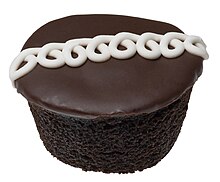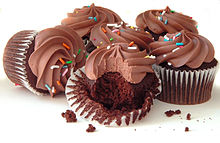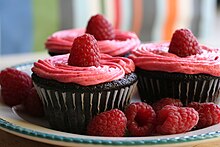Cupcake
A cupcake ( American English ; in British English also fairy cake ) is a small cake that is baked in a cup-sized baking pan and topped with a topping or a cream top. The name therefore comes that the dough originally in a cup (cup) was baked. The term cupcake is first written down in the American Cookery book by the American Amelia Simmons from 1796.
Cupcakes are an example of a food trend, the emergence of which is easy to understand: Cupcakes were a rather common type of pastry for a long time, but in the late 1990s, individual bakeries in New York began selling elaborately decorated cupcakes and met with lively customer interest. The trend was increasingly picked up by the media, and cupcakes developed into an “in” product with a hip nimbus in North America within a few years. The United States, Canada, and the United Kingdom are currently home to a variety of cupcake-themed cafes. In other countries, where sweet pastries are in a different cultural context, the trend has gained less foothold. However, there are also cafés and bakeries specializing in cupcakes in larger German cities.
Muffins are considered to be the forerunners of the current cupcake trend. Compared to muffins, cupcakes are sweeter, are made from batter , unlike muffins , and generally do not contain any nuts or the like. They are also given a topping after baking. The difference between cupcakes and muffins can be seen purely from the outside by the topping . Muffins usually don't have a cream top.
etymology
The English-speaking world knows a number of different terms for small cakes baked in cup-like shapes. In the United Kingdom , the type of pastry, for which the name cupcake has also become established in Germany, is originally called fairy cake (" fairy cake "). The American term cupcake is also being used more and more there . Originally the names Queen Cake and Vienna Cake were also used for such small cakes. The term cupcake has penetrated the vocabulary in the United States to such an extent that it has also become a term of endearment .
The term cupcake originally also referred to a cake whose ingredients are measured in cups ( cups , 1 cup corresponds to 236 milliliters). It is traditionally made in a ratio of 1 cup butter or margarine, 2 cups sugar, 3 cups flour and 4 eggs and baked in a large cake pan.
history

The history of the industrial production of this type of biscuit began shortly after the end of the First World War. The US company Hostess Brands launched a plastic-wrapped chocolate cupcake and sold it in grocery stores across the United States. The product found imitators in another form from the 1950s onwards. General Mills launched a cupcake mix under the brand name Betty Crocker , and so did Nebraska Consolidated Mills under the Duncan Hines brand . In 1963 the first “ Easy-Bake Oven ” came onto the market in the USA and quickly became widespread. Because of these toy ovens that could actually bake, and the availability of baking mixes, cupcakes were often among the first baked goods children made.
Muffins and cupcakes
In the second half of the 20th century, cupcakes, along with muffins, brownies and cookies, were standard baked goods in American shops and cafés . Cupcakes were usually offered in the flavors vanilla and chocolate, the respective cream topping or topping varied, but rarely made up more than 20 percent of the total weight of the pastry. In the 1970s and 1980s, muffins were much more popular with customers in the United States. David Sax sees the cause in the trend at the time to eat as high in fiber as possible. So-called bran muffins, i.e. muffins with a high proportion of bran, which were typically eaten with breakfast coffee, were considered healthy and this assessment was also transferred to similar products such as carrot muffins, blueberry muffins and the like. It was not until the late 1980s that the realization took hold that muffins, with their high fat and sugar content, are not among the healthier foods: Muffins gradually lost their dominant position in the assortment of American cafés.
Trendsetter Magnolia Bakery
Cupcakes began to replace muffins in popularity in the late 1990s. Unlike other food trends, the time and place of origin can be localized relatively precisely. Magnolia Bakery , located in New York's West Village , began selling buttercream-topped cupcakes in the fall of 1996 if there was any batter left over from making birthday cakes. The small cakes were very popular with customers. As early as 1997, there were occasional queues of customers who wanted this type of pastry in particular.
The Magnolia Bakery, which had only started operations in 1996, was also increasingly mentioned in the press, and some airline magazines referred to the bakery as New York's trendy location. In 1999, the New York Times reported in a short article on the increasing popularity of cupcakes and named several New York bakeries that now had them in their range. Magnolia Bakery differed from these other bakeries, among other things, in that it also had opinion leaders from the media world among its customers. This earned the bakery a contract with the Simon and Schuster publishing house in 1998. In the fall of 1999, The Magnolia Bakery Cookbook came on the market with two cupcakes on the cover.
TV series Sex and the City is making cupcakes a US-wide trend
On July 9, 2000 the episode obstacle course (original title of the episode: No Ifs, Ands, or Butts) of the series Sex and the City was first broadcast on US television. There is a short scene of the two actresses Sarah Jessica Parker and Cynthia Nixon in their roles as Carrie and Miranda respectively, which she shows on a bench in front of the Magnolia Bakery. Carrie has a cupcake while she discusses her current relationship problems with Miranda. The entire scene lasts only 20 seconds, but is considered to be the reason why the preference for cupcakes developed into a US-wide trend. David Sax calls this astonishing in his analysis of the emergence and termination of food trends, because other trends that owe their popularity to this series - including the Cocktail Cosmopolitan , shoes by designer Manolo Blahnik and a certain form of vibrators - are either a recurring theme or essential element of a single episode. One of the possible reasons is the city tours that took fans to locations of the series and visited Magnolia Bakery. Cupcakes, an actually unspectacular pastry that was baked for a long time mainly for children's birthdays, acquired a hip, sexy nimbus. In an interview with David Sax, Jennifer Appel, one of the two founders of Magnolia Bakery, pointed out that her clientele had changed noticeably after the episode was broadcast: the average client was now a young, strikingly slim woman.
Suspected trend causes
The author Christopher Nixon points out the increasing popularity of cupcakes in connection with the terrorist attacks of September 11, 2001 . The attacks would have sparked a desire for a feeling of security and a better, simpler world. Cupcakes are a symbol of such a world. Jean Ratzinger, who teaches media studies at the University of California, also points out that it helped that cupcakes were a well-known pastry that any American could easily classify. They were accessible, and even in a city that didn't have a cupcake bakery, you could buy the ingredients to make your own cupcakes. Especially for women who identified with the characters and the lifestyle of the series Sex and the City , it was an easily obtainable and (unlike the several hundred dollar Manolo Blahnik shoes) affordable symbol of modern femininity. As a result of the series, it became hip to serve cupcakes. Anyone who offered cupcakes instead of sliced cakes or tarts at their wedding or office party demonstrated class and sophistication.
David Sax also calls it essential for the cupcake trend that it originated in New York. The city has a high media presence, thousands of national and international journalists live in this city and are inevitably primarily aware of developments that take place in their immediate vicinity. The coverage of the success of some bakeries in cupcakes began casually in the local New York press, was picked up in other major magazines and newspapers, and then caught the attention of journalists from newspapers and magazines sold nationwide. Cupcakes had been a recurring topic in cooking magazines. One of the characteristics of the trend at the beginning of the 21st century, however, is that fashion and lifestyle magazines took up the topic and explicitly defined cupcakes as a new trend.
The cupcake trend also coincides with a change in the media world and the emergence of social media . Cooking programs that had previously been aimed primarily at women and a small, elite group of gourmets , were now aimed at a mass audience. Food Network , a New York television station exclusively focused on broadcasting programs about cooking, hospitality, restaurants, food and food manufacturing, had been in the market since 1993 and helped transform this form of broadcast into mass entertainment. Towards the end of 2009, the station began broadcasting Cupcake Wars , a cooking contest in which cupcake bakers compete against each other. About half a year later, the television station TLC began broadcasting DC Cupcakes . The reality show showed the everyday life of the well-known Washington bakery Georgetown Cupcake . As the Internet spreads , so does the rise of websites and blogs focusing on cooking and baking or reporting on food. Facebook and Twitter also contributed to cupcakes becoming a trend among the general public.
Economic importance in the USA
Newspapers also increasingly reported on the commercial aspects of the cupcake trend. In 2003, the New York Times reported that Magnolia Bakery was making $ 40,000 a week just selling cupcakes. The extensive coverage motivated a number of people in the United States to start companies that focused on making cupcakes. Cupcakes, as sold by bakeries such as Magnolia Bakery or the Crumbs Cupcake chain founded in 2003 , offered their standard products for a price of 3.50 to just under 4.00 dollars (around 3.10 to 3.70 EUR depending on the exchange rate) . Compared to the selling price, the manufacturing costs were low. The first bakery founded exclusively to produce cupcakes was Sprinkles Cupcakes in Beverly Hills . Especially during the financial crisis from 2007 , when many companies cut their workforce, this motivated people to set up their own cupcake bakery. Cupcake sales in the US grew 56 percent between 2008 and 2012, wholesale sales of cupcake-specific decoration materials and baking trays doubled between 2000 and 2010, and the number of bakeries specializing in cupcakes rose to 8,000 to 9,000 medium-sized businesses in 2012 estimated.
The cupcake trend also led to an extensive range of merchandising products . Johnny's Cupcake bakery also sold clothes in their stores with a pirate-like logo made up of a cupcake and crossbones. There are also children's toys and jewelry related to cupcakes.
preparation
Recipe

Cupcakes are similar to muffins . The American measuring system for baked goods (cups) determines the number of cupcakes in recipes for cupcakes. Since the recipes for the mass (dough) and the topping (cream) are based on the known units (1 cup, ¾ cup, ½ cup, ¼ cup, 1 tablespoon, 1 teaspoon), the result varies from recipe to recipe. Today, cupcakes are mostly baked in muffin tins lined with paper instead of a cup. The cupcake is then covered with a creamy cap ( icing or frosting ) and decorated with fruit, sugar pearls or the like. There is a wide selection of creams, ranging from cream cheese to a wide variety of buttercreams . The cream cap can be placed on the cupcake with a spatula, spoon or piping bag . Bakeries specializing in cupcakes also offer those that are decorated according to the occasion. The decoration is usually edible and consists of marzipan, fondant or the like.
modification
In the meantime, the traditional recipes have been modified both in terms of form and composition.
The sweet ones have also been joined by savory cupcakes, after there were initially mixed forms such as chilli-chocolate cupcakes or maple-bacon cupcakes. As with the sweet cupcakes, there are numerous options here. They can be prepared vegetarian or vegan as well as with fish or meat.
Since alcohol evaporates during baking, it was initially only used as a flavoring agent or as a leavening agent. An additional variant of adding alcohol as part of the taste experience was used with the Cuptails (Cupcake & Cocktail). Here, the cupcake is soaked with alcohol from a pipette before it is consumed.
Trivia
In June 2011, the British secret service cracked an al-Qaeda website calling for holy war and which also gave detailed instructions on how to make bombs. These instructions were systematically replaced with detailed cupcake baking and decorating instructions that the secret service had taken from a website in Ohio.
literature
- David Sax: The Tastemakers - Why we're Crazy for Cupcakes But Fed Up With Fondue . PublicAffairs 2014, ISBN 978-1-61039-316-4 .
- Martha Stewart: Martha Stewart's Cupcakes - 175 Inspired Ideas for Everyone's Favorite Treat. Clarkson Potter, Publishers New York 2009, ISBN 978-0-307-46044-8 .
Web links
Single receipts
- ^ Lynne Olver: Cupcakes - Cake History Notes. In: The Food Timeline. Retrieved July 1, 2017 .
- ↑ a b David Sax: The Tastemakers . P. 3.
- ^ David Sax: The Tastemakers . P. 6.
- ^ David Sax: The Tastemakers . P. 7.
- ^ David Sax: The Tastemakers . P. 8.
- ^ David Sax: The Tastemakers . P. 9.
- ^ David Sax: The Tastemakers . P. 10. Interview with Christopher Nixon.
-
^ David Sax: The Tastemakers . S. 11. Interview with Jean Retzinger. In the original, Retzinger said, among other things:
“… I suspect the cupcake becomes an Emblem of those characters on Sex and the City . If you identify with those characters and lifestyle, the cupcake is your road into it. "
- ↑ a b David Sax: The Tastemakers . P. 12.
- ^ David Sax: The Tastemakers . P. 19.
- ^ David Sax: The Tastemakers . P. 14.
- ↑ Julia Moskin: Once Just a Cupcake, These Days a Swell. In: The New York Times. March 11, 2003, accessed April 3, 2015 .
- ^ David Sax: The Tastemakers . P. 16.
- ^ Estimate by the US American journal Modern Banking , quoted in David Sax: The Tastemakers . P. 17.
- ^ David Sax: The Tastemakers . P. 18.
- ↑ Martha Stewart: Martha Stewart's Cupcakes. 2014, p. 22
- ^ David Sax: The Tastemakers . P. 21.







